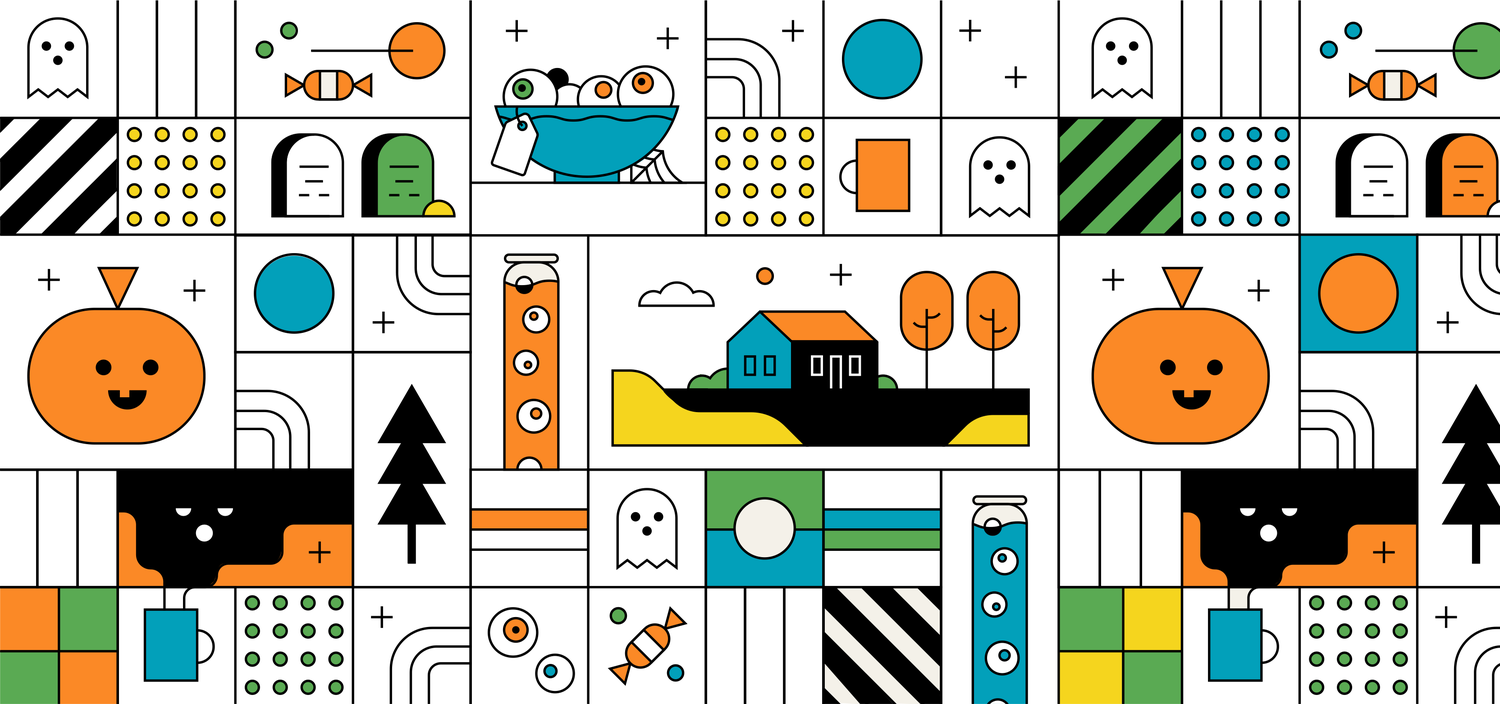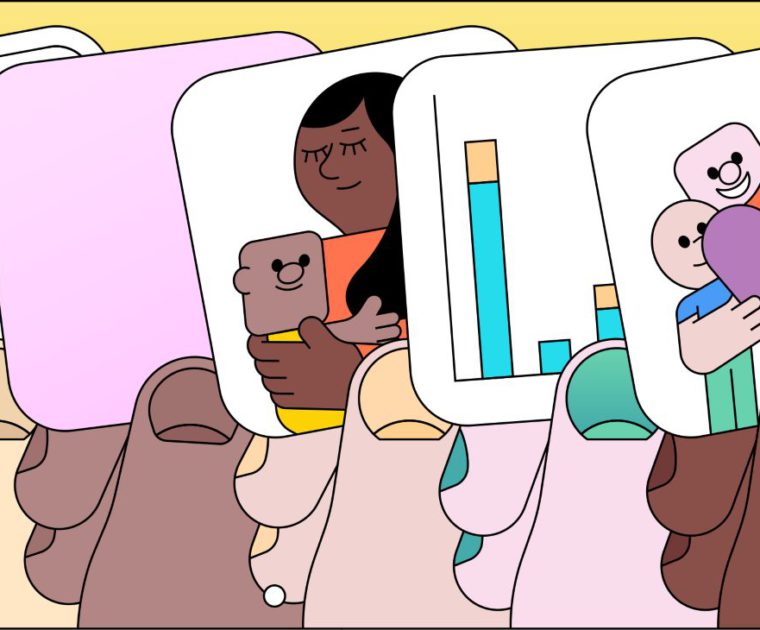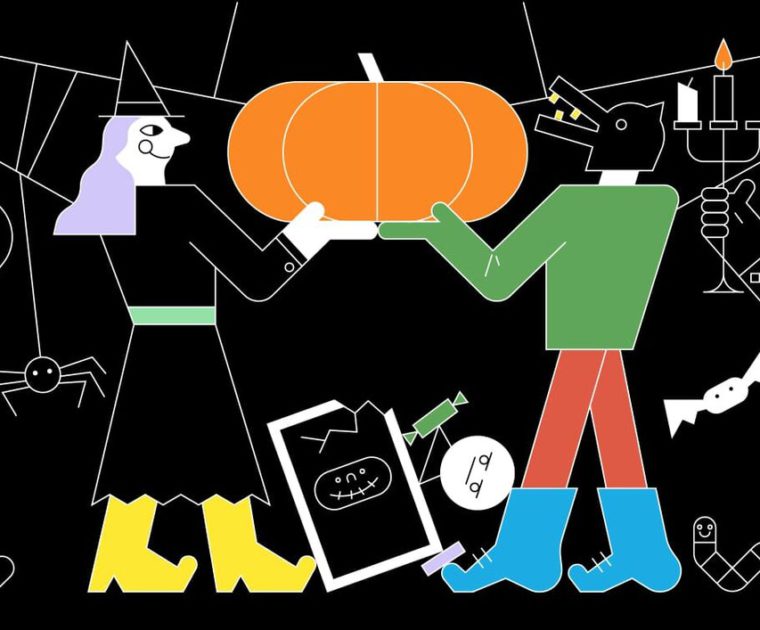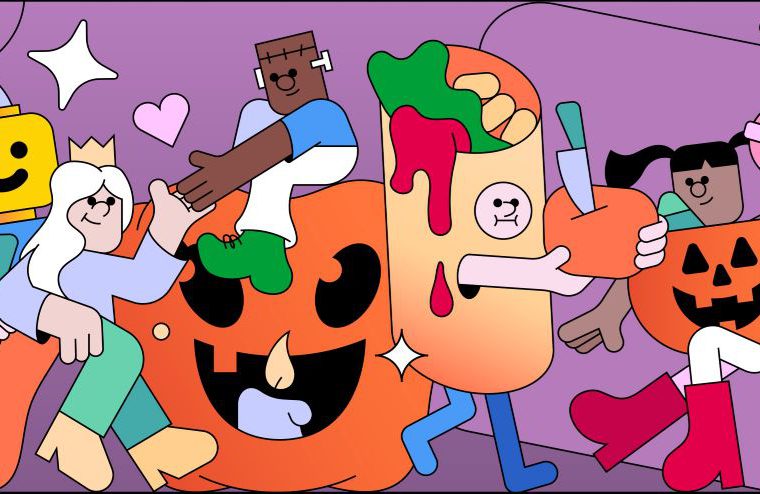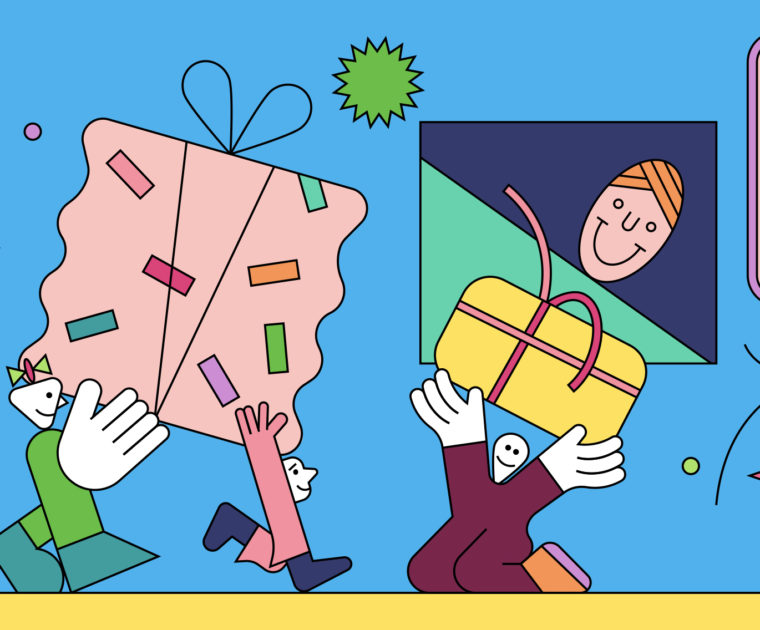Goblins, ghouls, and campaign goals, oh my! That’s right folks, Halloween is just around the corner. And you know what that means. It’s time to get your holiday campaign strategies under the right spell. We’ve rounded up nine Halloween trends that will take your campaigns from witchful thinking to killer results and pave the way for a fantastic winter holiday marketing season.
Take a look at the nine trends we’ve found bubbling up to the surface of campaign cauldrons.
Halloween is a Bona Fide Retail Event in the US
Halloween is celebrated in countries around the world… but it’s a bona fide retail event in the US… which is why we tend to focus our Halloween marketing content on American buyers. With 72 percent of Americans planning to celebrate and collectively spend $11.6B, there’s plenty of market share to go around. And there’s bound to be a Halloween trend that you can use to boost your brand this season.
Halloween is different from place to place, but it’s still Halloween. And whether festive and cartoonish or dark and menacing, people all over the world take part in their annual Halloween celebrations.
The yearly uptick in Halloween-themed content usually hits Pinterest starting in June. Yes, June. That’s when people really start planning for Halloween (and Thanksgiving and Christmas).
You may have noticed that shortly after Independence Day, the Halloween-themed stores started showing up. Not long after, pumpkins and jack-o-lanterns start lining store shelves and the sidewalks in front of stores. That’s because 47 percent of those celebrating the holiday plan to start shopping before October. And for at least half of consumers between the ages of 25 – 44, both the planning and shopping happen in the days and weeks leading up to October 1st.
Actual Halloween spending really starts to pick up in September (or even a little earlier). The average American celebrant plans to spend about $104 on Halloween stuff this year. Not bad.
To put this in perspective, the average family spends $5 per person celebrating Thanksgiving Day and about $75 per household to celebrate the Fourth of July. As far as spending goes, Halloween is a mid-tier retail holiday.
By the time September 1st rolls around every year, shoppers have already spent about $500M on Halloween-related purchases. That means, Back-to-School, Labor Day, Halloween spending, and holiday shopping now officially overlap every year. But most Halloween spending (55 percent of it) happens in October.
WHICH MEANS…
Right now, they’re planning, Pinning, bookmarking, saving, Liking, Following, “tutorialing” and budgeting. So, it’s the perfect time to roll out your Halloween marketing campaign on social media to help you sell a lot now and sell even more over the next few months
The world’s spookiest retail event is growing, but it’s also evolving in some really important ways. We’ve put together a list of the things we see in the data that are shifting in this space. Plus, tips on how you can leverage this info to help you better target your Halloween marketing campaigns. And of course, each one of these ideas provides a seamless opportunity for you to incorporate influencer marketing, even if you’re not necessarily working with Halloween influencers.
Halloween Trend #1: Using the #FYP For Halloween Inspo
TikTok trends are the stuff that Halloween costumes are made of. According to Spirit Halloween, trends that were super popular in 20204 – like the Mob Wife Aesthetic and Skibidi toilet (you know… for the kids 👀) – are hot picks among Halloween costume shoppers. But it’s not just TikTok that’s drawing people in and pushing ideas out. Other popular platforms including YouTube and Pinterest are named among the top sources of Halloween inspiration for both decorations and costume ideas.
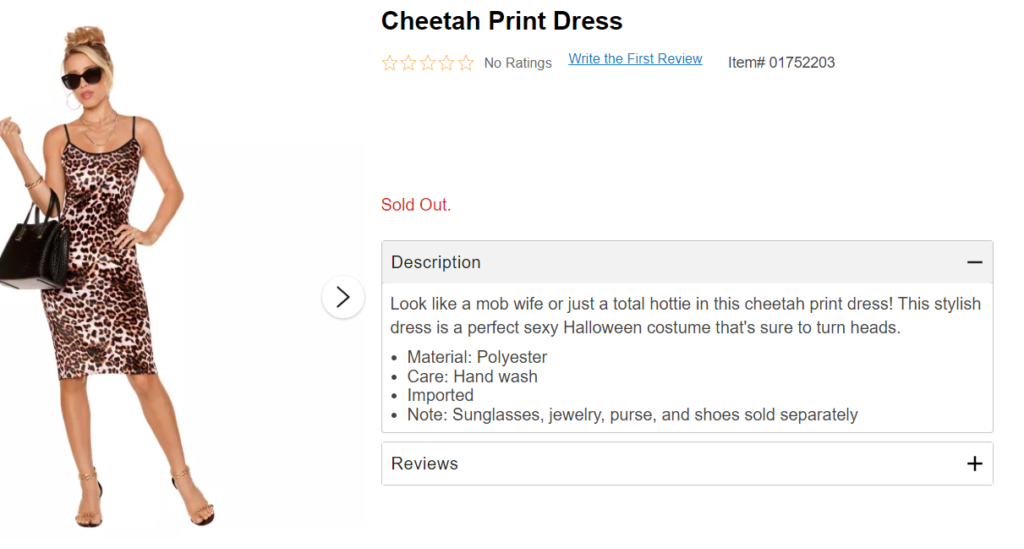
How to Use This In Your Marketing Strategy
It’s always a good bet to know where your audience is spending time online. We know that younger consumers a skewing toward platforms that display content based on interest not relationship, namely TikTok, Instagram, YouTube, and Pinterest. These could be pretty keen signals that this group searches for Halloween-related content topically (i.e. “Bluey costume ideas” or “funny Halloween costumes for couples”). That means you need to lean into creating content that focuses on a single topic and that the content is optimized for that topic. By that, we mean optimize posts with hashtags and the words you use in your caption, and optimize your rich media so it’s searchable online.
Halloween Trend #2: Sustainability
This year, the Halloween spirit comes with a green twist! Sustainability is all the rage, as more consumers are opting for eco-friendly costumes, decorations, and treats. From thrifted outfits to homemade decorations crafted from repurposed materials, the emphasis is on reducing waste and celebrating the season without the environmental guilt. According to a recent survey, nearly 40% of consumers say they’re more inclined to choose sustainable products this Halloween. Brands that embrace this trend are not just tapping into a growing market; they’re aligning with a value-driven mindset that resonates with consumers.
How to Use This Strategy
Understanding your audience’s growing commitment to sustainability can give your brand a significant edge. As more consumers, especially younger ones, prioritize eco-friendly practices, it’s essential to showcase your commitment to sustainability in your marketing strategies. Consider highlighting sustainable options in your product offerings—think costumes made from organic materials or decorations that can be reused year after year. Use social media to promote these sustainable practices, sharing tips on how to celebrate Halloween without excess waste. Collaborating with local thrift shops or hosting upcycling workshops can also engage your community and position your brand as a leader in sustainable Halloween celebrations. By making sustainability a core part of your Halloween narrative, you’ll attract conscientious consumers looking for guilt-free ways to celebrate.
Halloween Trend #3: Interactive Spooky Family Fun
This Halloween, it’s all about getting hands-on! Families are trading traditional trick-or-treating for interactive experiences that offer a blend of fun and adventure. From escape rooms designed with a spooky twist to themed scavenger hunts that lead participants through haunted neighborhoods, the focus is on creating memorable, engaging activities. A recent survey found that 62% of families plan to participate in interactive Halloween activities this year, showcasing a shift towards experiential celebrations that everyone can enjoy together. Woohoo!
How to Use This Strategy
To capitalize on this trend, consider how your brand can facilitate these engaging experiences. Hosting themed events or partnering with local attractions can drive foot traffic and create excitement around your offerings. Think outside the box—maybe a pumpkin-carving contest or a Halloween trivia night at your venue. If you have a product that lends itself to DIY projects, promote it through how-to videos or kits that encourage families to create together. Utilizing social media platforms to share user-generated content from your events can help build community and engagement while promoting your brand as a go-to destination for Halloween fun. By fostering a sense of participation and connection, you’ll create lasting memories for your audience this spooky season!
Halloween Trend #4: Grown-Up Only Halloween Shenanigans
Getting the full fright of Halloween is a BIG part of Halloween celebrations for older celebrants, and especially the 18 and over crowd. This year, 67 percent of happy Halloweeners plan to hand out candy, 52 percent will decorate their home or yard, 52 percent will wear costumes, 43 percent will carve a pumpkin, 29 percent will throw or attend a party. It’s worth noting that a larger percentage of Halloweeners will be decorating their hards and wearing costumes compared to last year, while fewer will be handing out candy, carving pumpkins, and throwing or attending parties.
HAUNTED ATTRACTIONS. In the spirit of grown-up Halloween activities, haunted attractions continue to grow in popularity. Some of us. remember when haunted houses were literally a 4-person cart zigzagging on a rickety track through the detached container of an 18-wheeler. Me. I’m some of us.
Today, the haunted house industry is… well, an industry. I want to tread lightly here, as the haunted attraction industry is still formalizing despite its explosive growth, and it’s not easy to find up-to-date stats. About 32M people are expected to visit 4,000 U.S.-based haunted attractions this year, each averaging between $20 and $40 per ticket.
HALLOWEEN POP-UPS. Each fall, cities come alive with pop-up Halloween attractions, and one of the most anticipated is Nightmare on Bagley in Detroit. This unique experience transforms the local landscape into a haunted haven, offering visitors a chance to immerse themselves in spine-chilling themes, interactive scares, and festive atmospheres. According to recent reports, pop-up haunted experiences have surged in popularity, drawing in crowds eager for both thrills and community engagement
How to Use This Info in Your Marketing Strategy
Experiences are the bee’s knees, man. And the popularity of attractions is proof-positive that adults – not kids – are the target audience this Halloween. Haunted attractions have been labeled a 100 percent American export. The fastest-growing market for haunted attractions outside the U.S is the Asian market.
As well, the rise of computer-generated graphics in Hollywood movies has created an opportunity for makeup artists who specialize in film makeup and horror makeup to offer their services – at least on a part-time basis – to haunted attractions to help create different looks.
Lastly, the emergence of year-round extreme haunts and offshoots of haunted attractions like haunted hayrides, zombie paintball, escape rooms, and virtual haunted houses are on the rise, and making their post-pandemic comeback.
The science behind haunted attractions is that they provide a way for people to be downright terrified and to legitimately feel threatened but have an “out” so to speak. Haunted attractions are a great way to be afraid and in a safe place at the same time.
Corporate backing and sponsorships of haunted attractions are on the rise. Melissa Cardone’s Ten Thirty-One Productions creates spooky hayrides and other haunted events in both Los Angeles and New York. Cardone got a $2 million investment (for a 20 percent stake in her company) from Mark Cuban during her “Shark Tank” pitch in 2013.
Now, you may not be ready to drop two rocks on a haunted attraction like Mark Cuban can, but partnerships may make sense for your business. For instance, drink startups may consider striking a deal with haunt production companies to provide energy drinks, soda, water, or novelty foods. Smaller brands could target local haunts to provide novelty items, screen-printed apparel, or partner programs that provide discounts for haunted house patrons who visit their establishment within the same day.
Halloween Trend #5: Large Outdoor Decorations – We’re Doing It Big!!
Both the Halloween and Christmas seasons saw jumps in decoration sales as people sought safe ways to drum up holiday spirit while maintaining social distance. So, if you’re wondering if you’ve just been ignoring all the giant scarecrows and metal pumpkin yard stakes all these years, you haven’t. Super-sizing our fall decor is just one of the ways we’re trying to keep the melancholy away and solidify our new normal.
And these high-tech Halloween decorations present great photo opps for passersby.
Per-household spending on Halloween decorations is up more than 50 percent over the last ten years from $20.99 per household to $33.57 per household this year. Not a bunch, right? Doesn’t seem like a huge shift in Halloween spending. But we’re talking a jump from $2.6 billion spent in 2020 to $3.8 billion in 2024. And it’s worth noting that 32 percent of Halloweeners are planning to reuse at least some of their decorations.
How to use this info in your marketing strategy
Halloween decorators aren’t limited to the stuff you find in the discount stores. And people aren’t always so thrilled to throw purple and orange into their home decor. Both good news because it provides brands with an opportunity to help Halloween shoppers dream up Halloween decorating ideas that won’t ruin their decor.
Share Halloween Accent Ideas
For companies that sell home goods, crafts, used items, furniture, or interior design services the goal should be generating and sharing ideas that include your products. Think about coming up with ideas that will allow customers to transition their interior design from Halloween to Thanksgiving without completing revamping their home.
In the post below, I spy with my little eye… a chic white ottoman, what looks like a vintage clock – similar to something you’d grab from a resale shop and paint black, bats made from construction paper (hello, crafting with the kids!), an oversized mug I can make myself or pick up from my local discount store, a comfy-looking couch, decorative pillows that can be store-bought or made with a little bit of fabric.
Bonus: When it’s time for Thanksgiving, one would only have to swap out the pillows and the blanket, remove or replace the bats, and add warmer colors to the existing collection of knickknacks to make the Halloween-to-Harvest transition simple.
Know what would be cool? A post that shows how a shopper can double-down on seasonal decor by telling them how to use $57 to decorate for both Halloween and Thanksgiving. Something like…
- Spend up to $7 at your favorite Goodwill or local resale shop on an accent piece (clock, oversized plate, creepy painting (resale shops are BRIMMING with horrible, homemade artwork that can easily be rebranded as kitschy.
- Buy 3 yards of the z-pattern fabric from Joann Fabric (on clearance this week for $3.97/yd)
- Buy 5 yards of orange fabric from Walmart (regular price $1.99/yd)
- Buy 3-piece floating shelves from Walmart $10.99
And so on and so on…
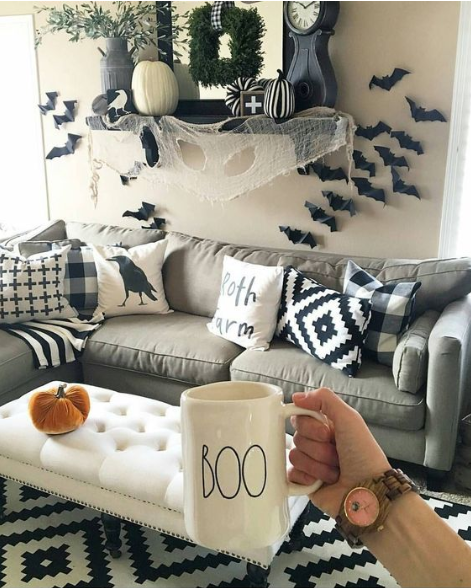
Create Transformation Videos
Another smart idea for creating Halloween marketing campaigns or themed content is to show and not just tell. This strategy translates really well on social media.
Take this example from Lowe’s Home Improvement. They created a campaign where they showed, through Instagram stories, how to transform a vertical space from drag to fab.
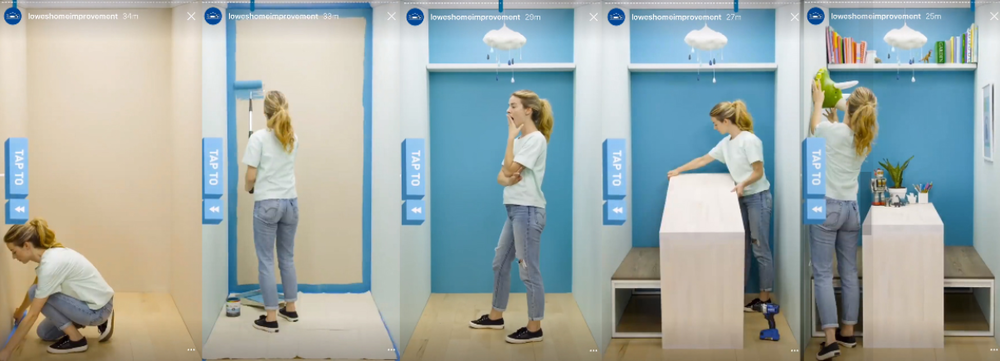
Another Halloween marketing idea: Mis En Scene the HECK out of your office or store
So, this Halloween is going to have a lot to do with setting the mood, and getting people in the holiday spirit without necessarily having to get them into the store to do it. People are shopping earlier. Even as we write this article, we’re only a few days out from the second Prime Day of the year. And this is the perfect time to focus on boosting your visibility with some fun decorating ideas.
- Update your window displays, storefront or facade with over-the-top holiday-inspired decorations.
- Add offbeat Halloween elements to offices, conference rooms, and break rooms in parts of your office or building that are okay to post on social.
- Sponsor a local haunt or a crawl of the 10 best Halloween decorations (with the owners’ permission and some fanfare, of course)
This may seem like a small thing, but it isn’t. You want your audience to like, trust, and support you. And that starts by being a brand that is actively engaged in your community – whether online or offline. Consumers are looking to spend money with companies whose culture and values they can support.
Halloween Trend #6: DIY Halloween Costumes Are Inflation-Proof
Interestingly enough, even though more people are planning to spend money on decorations than on costumes, Halloween costume expenditures make up the largest share of Halloween spending.

Come on… don’t you remember how excited you were to dress up in your not-so-ridiculous pumpkin suit, Ghostbusters outfit or a witch with the most awesome pointy hat and magical wand?
Of all the moms and dads who get dragged out on Halloween to beg strangers for sweets, Millennials are one group of adults who may be doing it willingly… without the kids. And while many Gen Zers aren’t yet parents, the numbers say they’re in it for the candy, too.
How to use this info in your Halloween marketing strategy
A great Halloween costume is worth its weight in Likes, shares, and retweets. But for Millennials and Gen Z partiers, there’s likely to be a little innovation as well. That usually means planning well in advance and sourcing ideas on social media instead of store racks.
An estimated 38 percent of Halloween shoppers will source inspiration from online searches, compared to the 26 percent that will go in-store to find ideas. That means your content strategy has to get you found in searches for popular search terms like…
- Halloween costume ideas (enormous number of monthly searches for this one with very little competition, comparatively)
- Halloween costume ideas for couples (another big one)
- DIY Halloween costume ideas
- Creative Halloween costume ideas
- Halloween costume ideas for groups (another surprisingly big one)
That said, creating visual content that ties your brand into Halloween-related themes is key. Pinterest is an invaluable tool for sourcing inspiration for looks of all kinds. Even if your team does most of its targeting on Facebook and Instagram, it will only help you to partner with influencers who can help you repurpose your content for Pinterest, YouTube, and IGTV.
Halloween Trend #7: Pop Culture Costumes
Pop culture costumes are taking center stage this Halloween, with fans eager to embody their favorite characters from movies, TV shows, and viral trends. From the latest blockbuster hits to classic favorites, inspiration for costumes can be found in a treasure trove of discussions on platforms like Reddit, where users exchange ideas, share photos, and even collaborate on group costumes.
The screenshot below shows a Halloween Costumes group with 80K members, and conversations around Halloween costumes starting mid-summer.

A recent survey highlighted that nearly 45% of Halloween celebrants plan to dress as pop culture icons, signaling a strong shift towards recognizable and relatable figures.

Not only do these costumes allow fans to express their love for beloved characters, but they also provide a fun conversation starter at parties and events.
How to Use This Strategy
For brands, leveraging the pop culture costume trend offers a unique marketing opportunity. Create content that taps into these trending characters, offering DIY costume guides, makeup tutorials, and themed accessories. Collaborate with influencers who resonate with these pop culture references to reach a wider audience. Engage with the community by encouraging fans to share their costumes online, perhaps through a contest or a hashtag campaign. By aligning your products with the excitement of pop culture costumes, you can capture the spirit of Halloween while driving engagement and sales.
For even more costume inspiration, check out the latest threads on Reddit, where creativity knows no bounds!
This Year’s Big Wrap-Up Isn’t Really That Scary
The big takeaway here is that people are loosening their hold on candy and trick-or-treating as the be all end all of Halloween. This current evolution of Halloween trends means there’s room for brands to dream up family friend experiences… or horrifying ones. Depends on your brand and your demographic.
Is anyone else thinking this is an amazing eyeshadow color? Source: Instagram @worldofsfx
But the one thing that is consistent throughout all eight of the trends we talked about here is that the experience you create has to be grand enough, interesting enough, and unique enough to make it into your customer’s Instagram feed. That’s the ultimate goal.


